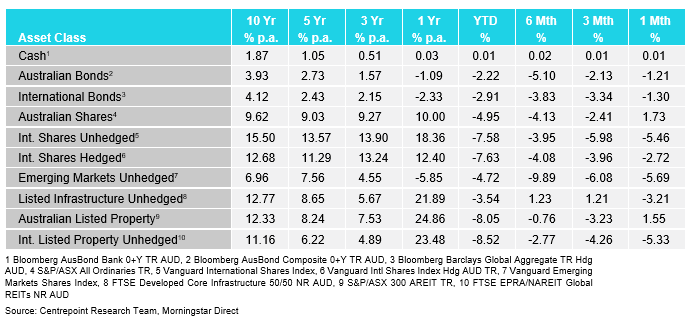Market Review – February 2022
How the different asset classes have fared:
(As at 28 February 2022)

International Equities
Unhedged and hedged international equities exposures again finished down in the month of February. Unhedged fell 5.46% hedged fell 2.72%. Whilst the markets were trending downwards due to the impacts of rising rates and inflation, Russia’s invasion of Ukraine in the last few days of February really spooked markets further to the downside as the costs and repercussions of war were priced in. The United States makes up a significant proportion of this this index and has been impacted severely by the current economic environment due to the high weightings of Technology stocks in their indexes. Technology stocks have fallen he most out of any sector across the last months.
Australian Equities
The S&P/ASX All Ordinaries Index actually rose 1.73% on the month. This was in stark contrast to the international equity’s indices. Australia finished positive by the index weightings to energy, materials, consumer staples and financials. As previously stated, Australia has higher weightings than other international indexes in the materials, energy and financial sectors which has helped soften the impact of rising rates and inflation. The War in Russia and Ukraine sent materials and energy much higher to end the month due to the supply constraints getting priced in, this in turn, benefited some of Australia’s largest companies.
Domestic and International Fixed Income
Both Australian and International Fixed Income fell 1.21% and 1.3% respectively on the month. The long-end 10-year yield curves rose across the world throughout February. This was the main contributor to the losses on the month. Generally, falling equity markets will cause bond prices to rise for protection against equity risk. This hasn’t occurred substantially yet as Central Banks are looking to only start raising rates in March. This puts upward pressure on yields. Central Banks seem to be more concerned with stopping inflation than coming to the rescue of equity markets, hence why equity markets and bond markets are both falling at the same time.
Australian Dollar
The Australian Dollar (AUD) rose in February as money flowed into the domestic market. This occurred due to the high index weightings in sectors that tend to benefit from the current environment of higher commodity prices and higher rates. There was significant volatility during the days of the Russian invasion of Ukraine, however it ended spiking upwards in the final day of the month. This is not saying the Australian market is protected from what is happening globally, however during this month is was seen as a safe haven of sorts.
Disclaimer
The information provided in this communication has been issued by Centrepoint Alliance Ltd and Ventura Investment Management Limited (AFSL 253045).
The information provided is general advice only has not taken into account your financial circumstances, needs or objectives. This publication should be viewed as an additional resource, not as your sole source of information. Where you are considering the acquisition, or possible acquisition, of a particular financial product, you should obtain a Product Disclosure for the relevant product before you make any decision to invest. Past performance does not necessarily indicate a financial product’s future performance. It is imperative that you seek advice from a registered professional financial adviser before making any investment decisions.
Whilst all care has been taken in the preparation of this material, no warranty is given in respect of the information provided and accordingly neither Centrepoint Alliance Ltd nor its related entities, guarantee the data or content contained herein to be accurate, complete or timely nor will they have any liability for its use or distribution.
